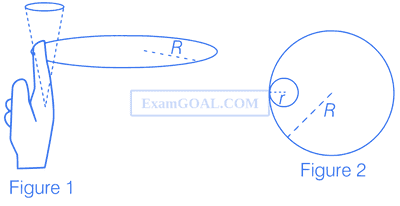1
JEE Advanced 2020 Paper 1 Offline
MCQ (Single Correct Answer)
+3
-1

A small roller of diameter 20 cm has an axle of diameter 10 cm (see figure below on the left). It is
on a horizontal floor and a meter scale is positioned horizontally on its axle with one edge of the scale
on top of the axle (see figure on the right). The scale is now pushed slowly on the axle so that it
moves without slipping on the axle, and the roller starts rolling without slipping. After the roller has
moved 50 cm, the position of the scale will look like (figures are schematic and not drawn to scale)


2
JEE Advanced 2017 Paper 2 Offline
MCQ (Single Correct Answer)
+3
-0.75

Consider regular polygons with number of sides $$n=3,4,5....$$ as shown in the figure. The center of mass of all the polygons is at height $$h$$ from the ground. They roll on a horizontal surface about the leading vertex without slipping and sliding as depicted. The maximum increase in height of the locus of the center of mass for each polygon is $$\Delta $$. Then $$\Delta $$ depends on $$n$$ and $$h$$ as


3
JEE Advanced 2017 Paper 2 Offline
MCQ (Single Correct Answer)
+3
-0

One twirls a circular ring (of mass M and radius R) near the tip of one's finger as shown in Figure 1. In the process the finger never loses contact with the inner rim of the ring. The finger traces out the surface of a cone, shown by the dotted line. The radius of the path traced out by the point where the ring and the finger is in contact is r. The finger rotates with an angular velocity $$\omega$$0. The rotating ring rolls without slipping on the outside of a smaller circle described by the point where the ring and the finger is in contact (Figure 2). The coefficient of friction between the ring and the finger is $$\mu$$ and the acceleration due to gravity is g.


The total kinetic energy of the ring is
4
JEE Advanced 2017 Paper 2 Offline
MCQ (Single Correct Answer)
+3
-0

One twirls a circular ring (of mass M and radius R) near the tip of one's finger as shown in Figure 1. In the process the finger never loses contact with the inner rim of the ring. The finger traces out the surface of a cone, shown by the dotted line. The radius of the path traced out by the point where the ring and the finger is in contact is r. The finger rotates with an angular velocity $$\omega$$0. The rotating ring rolls without slipping on the outside of a smaller circle described by the point where the ring and the finger is in contact (Figure 2). The coefficient of friction between the ring and the finger is $$\mu$$ and the acceleration due to gravity is g.


The minimum value of $$\omega$$0 below which the ring will drop down is
Questions Asked from Rotational Motion (MCQ (Single Correct Answer))
Number in Brackets after Paper Indicates No. of Questions
JEE Advanced 2025 Paper 1 Online (1)
JEE Advanced 2023 Paper 1 Online (1)
JEE Advanced 2022 Paper 2 Online (1)
JEE Advanced 2022 Paper 1 Online (1)
JEE Advanced 2020 Paper 1 Offline (1)
JEE Advanced 2017 Paper 2 Offline (3)
JEE Advanced 2016 Paper 2 Offline (2)
JEE Advanced 2016 Paper 1 Offline (1)
IIT-JEE 2012 Paper 2 Offline (4)
IIT-JEE 2012 Paper 1 Offline (2)
IIT-JEE 2008 Paper 2 Offline (3)
IIT-JEE 2008 Paper 1 Offline (1)
IIT-JEE 2007 Paper 2 Offline (2)
IIT-JEE 2006 (1)
IIT-JEE 2001 (1)
IIT-JEE 2000 (1)
JEE Advanced Subjects
Physics
Mechanics
Units & Measurements Motion Laws of Motion Work Power & Energy Impulse & Momentum Rotational Motion Properties of Matter Heat and Thermodynamics Simple Harmonic Motion Waves Gravitation
Electricity
Electrostatics Current Electricity Capacitor Magnetism Electromagnetic Induction Alternating Current Electromagnetic Waves
Optics
Modern Physics
Chemistry
Physical Chemistry
Some Basic Concepts of Chemistry Structure of Atom Redox Reactions Gaseous State Chemical Equilibrium Ionic Equilibrium Solutions Thermodynamics Chemical Kinetics and Nuclear Chemistry Electrochemistry Solid State Surface Chemistry
Inorganic Chemistry
Periodic Table & Periodicity Chemical Bonding & Molecular Structure Isolation of Elements Hydrogen s-Block Elements p-Block Elements d and f Block Elements Coordination Compounds Salt Analysis
Organic Chemistry
Mathematics
Algebra
Quadratic Equation and Inequalities Sequences and Series Mathematical Induction and Binomial Theorem Matrices and Determinants Permutations and Combinations Probability Vector Algebra 3D Geometry Statistics Complex Numbers
Trigonometry
Coordinate Geometry
Calculus



